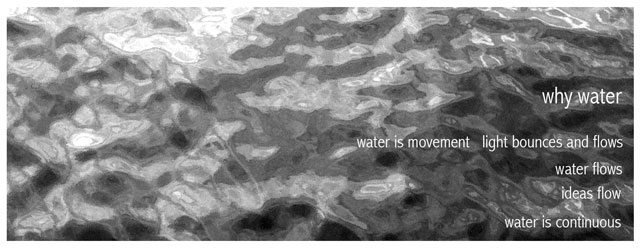 Nancy Agati
Nancy Agati
NOTICING WATER: Public Art
As you travel along the river—any river, stream, creek or body of water—what do you notice? Do you see the changing currents, the light that bounces and travels from wave to wave? Do you feel the rush of water at a rock’s edge? Can you hear water lapping at the shore? Do you sense the flow that ceases to part as it travels?
I believe that there are times when one becomes acutely aware of the act of perceiving. There are moments when a heightened sense of awareness highlights things that might otherwise go unnoticed. Trying to accurately describe this sensation, this shift in perception, is difficult. There is a certain silence in the experience, it overcomes you and narrows your focus. Like a camera the eye zooms in, crops, and brings into view specific visual aspects of life. Objects in nature can take on a presence and that presence for a short period of time heightens all the senses. I wonder if this happens to everyone, or if it is a gift or curse for the artist? When I begin to experience this shift in perception (and the moments are fleeting), I want to share the vision. These are the times when I notice what I am noticing.
My work often focuses on the things that I presume go unnoticed in the world: the tiny veins of a decaying leaf, the pattern of light bouncing off a flowing stream, the millions of cracks and slivers in a broken piece of glass. In the process of making, I attempt to expose and redefine those unnoticed fragments from life.
The movement of water has been a recurring subject in my work for quite some time. It began as an exploration of light, depth, color, and translucency. The initial works investigating water consisted of a series of small paintings on Mylar. The smooth material allowed me to manipulate the manner in which the watery pigments flowed across the surface. These three paintings, entitled Arroyo Hondo, are part of an extended group of images that focused on the depth and flow of water along the Wissahickon Creek in Philadelphia.

I soon realized that my attention to a form of visual awareness, along with a fascination with water, tended to be revealed through light. My interests quickly shifted from making intimate paintings to building sculpture and site-specific installation projects that could engage the viewer in a more physical manner. I first had an opportunity to create a large-scale public art piece in 2005 at THE LAND/an art site in Mountainair, New Mexico. This work, entitled Fluir, meaning “to flow,” was based on wind and water patterns from the area. Fluir consisted of four silk panels, two of which had patterns of wind and water movement burned into the silk with incense sticks.

When sunlight shone through the patterned panels, the light streaming through the burned holes created a mirrored pattern on the solid silk sheets. The patterns shifted and appeared to flow throughout the day due to the angle of the light and the direction of the wind.
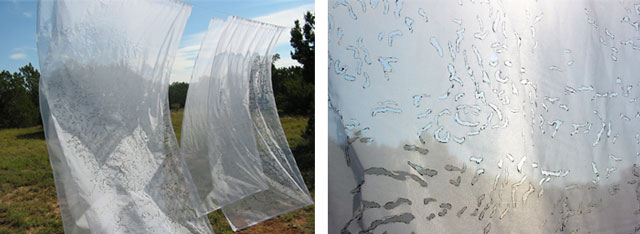
I am interested in the way in which the process and concept of one work can inform and lead to another. The repetition of mark making based on the wind and water patterns for Fluir led to observations of visual similarities or analogies of pattern. As I continued to pay attention to the patterned flow of water and its interactions with light, I began to take note of analogous patterns found in nature.
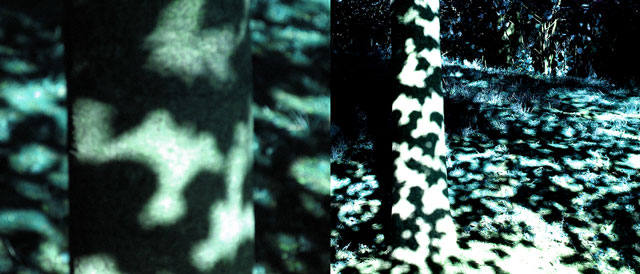
One such visual analogy was that of growth patterns of tress to the flow and movement of water. From this interest arose a piece entitled Trees are Like Water, a photo light box made in 2007. The images were shot along a stand of maple trees in the spring. On this particular morning the sunlight cast deep camouflage shadows of the leaves across the trunks of the trees and in circular patterns along the ground. The framed image is a photographic diptych of the same tree and its surroundings from two separate vantage points.
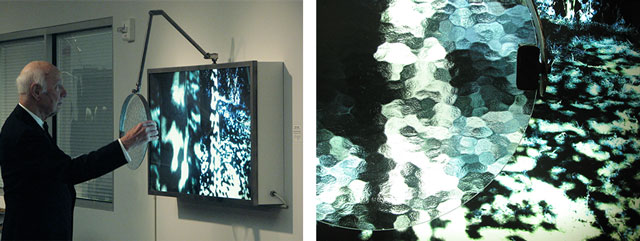
The diffusion glass, held by a movable arm, is situated in front of the image for viewing sections of the photograph. The viewer is invited to grasp the scope and readjust it to observe portions of the image. The glass scope defines the vantage point for viewing and engaging with the work. Although it appears as a focusing device, its wavy, diffused texture is actually intended to further break up and distort the image while offering the illusion of movement. Color and light revealed through the glass mirrors the phenomenon of light reflecting along the surface of water or the reflection of trees upon a flowing stream. By observing the blue-green photograph through the scope the viewer sees an image which suggests the existence of a visual analogy between forms of water and other natural elements, such as trees.
It is in the juncture between active seeing or perceiving, and the unconscious or passive glance, that I want my artwork to exist. Several recent public art projects have offered me an opportunity to continue to explore the act of seeing and perception. The project that I undertook for Art in the Open Philadelphia, in 2010, emphasized the manner in which we see, recognize, and identify visual input. It was designed to directly engage the viewer, and the format invited participants into an intimate experience of meditating on a small, defined section of the Schuylkill River. For this project, River Meditation, a simple viewing device was constructed to isolate a segment of the Schuylkill River. Audience members listened to a guided meditation and instrumental music that muffled nearby highway noise, while gazing through the viewfinder directed at the water. The concept was to create a singular area of focus in order to draw attention to the intricacies and beauty of flowing water.
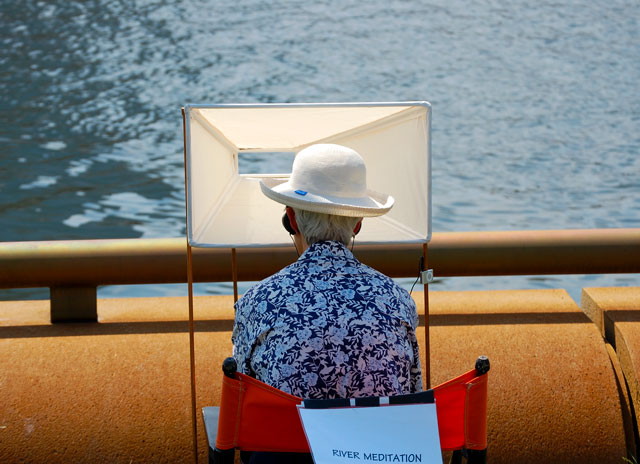
The intention was to offer the work as a means for reflection and to allow the viewer to take note of something that may have gone unnoticed. The viewing area was purposely quite small, blocking out the river surroundings in order to direct the gaze. This vantage point accentuated the pattern of movement, the flow of currents, and the effect of light on the water. Surprisingly, many participants noted experiencing an abstraction of the scene that consequently altered their perception of the water.
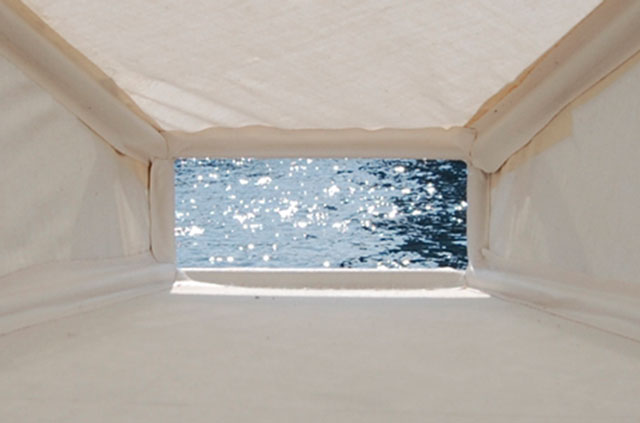
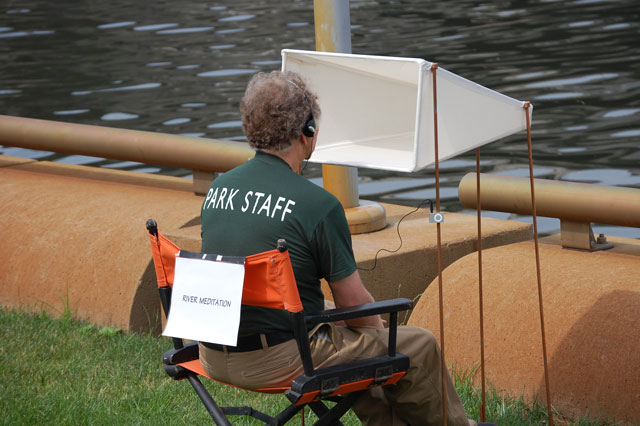
Churn Ripple Flow was proposed and executed for Philadelphia’s 2014 Art in the Open event. Again, it was the movement and flow patterns of the Schuylkill River that led the way for this public participation project. To begin the process, photographs were taken from different viewpoints along the river from The Waterworks to Locust Street. From these photos, drawings were made on six-foot lengths of pine boards. The patterns on each board were then edged with a router in the studio. There were three 18-foot triptychs, each representing a different flow pattern: the churning water from over the falls, ripples from wind across the water’s surface, and the gentle flowing water between Chestnut and Locust Streets.
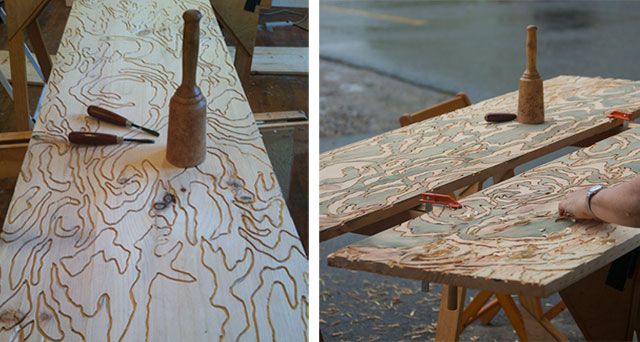
During the three-day outdoor event, the public was invited to assist with carving the negative spaces of the patterned boards in order to create a series of large-scale engraved wood blocks. Over 100 participants, adults and teens, took part and lent a hand to carve the patterns. Most people worked for 15-20 minutes at a time, several stayed and worked for more than an hour. One woman, Yuvette, worked on a panel for over two hours, then returned the following day to help complete the piece. The objective of Churn Ripple Flow was for the public to intently observe the patterns, reflections, and currents on the water’s surface as they learned simple carving techniques along the river’s edge. Jody Walker, one of the first contributors, stated that “it felt like you were on the water, because your hands were moving with the pattern and in the direction of the water.” Karen Young, director of Fairmount Waterworks Interpretive Center, described the process as “very relaxing, meditative, and mindful.”
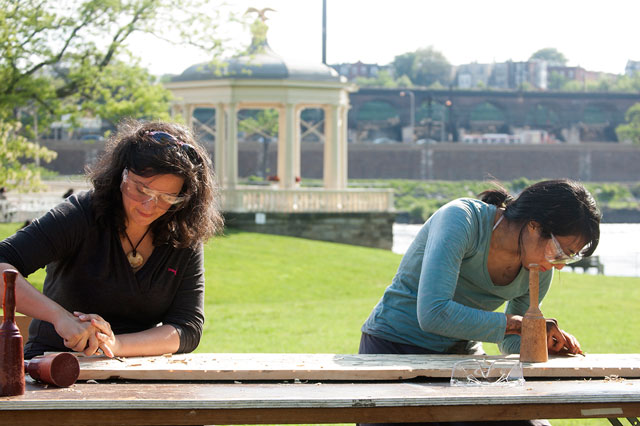
The positive effects of the carving process were a welcome benefit, and somewhat of a surprise, for many who expressed enjoying the focused nature of the task, the peaceful sounds of mallets and chisels, and the act of slowing down—taking time to create.
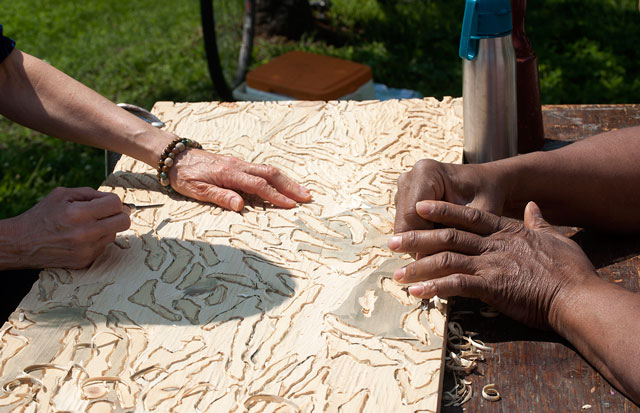
Public art projects offer an opportunity to work in an alternative manner, engaging the viewer and creating alongside them. I am interested in continuing to design audience participatory works that present the concepts by which we see, perceive, notice, and experience our surroundings.
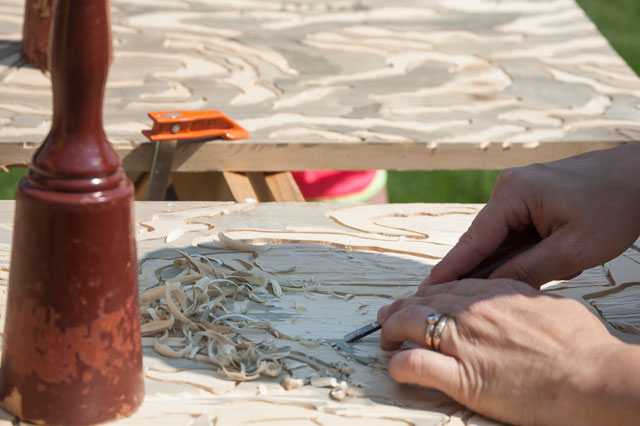
The meditative quality of the art making process and the act of seeing are areas for in-depth investigations within my work. I anticipate that the flow of water will return and ripple through my mind’s eye, as I attempt to remain aware and develop works from that which I notice.
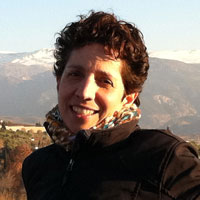 Nancy Agati’s work addresses transformations in nature, and often speaks of time elements through physical investigations of materials. She has exhibited her work throughout Philadelphia and nationally, with solo exhibitions at Pentimenti Gallery, Philadelphia; Hillyer Art Space, Washington, DC; Whitaker Center for Science and the Arts, Harrisburg; The Crane Arts Building, Philadelphia; Abington Art Center, Jenkintown, PA; ARC Gallery and Educational Foundation, Chicago; and others. She holds a BFA in Painting and Printmaking from Alfred University and an MFA from The University of the Arts. In 2012, she worked as an artist-in-residence at Lo Studio dei Nipoti in Calabria, Italy. Recently awarded a Tending Space Fellowship from the Hemera Foundation, Nancy has been investigating the intersection of mindfulness and meditation as it relates to the art making process. For more information visit her website: www.nancyagati.com.
Nancy Agati’s work addresses transformations in nature, and often speaks of time elements through physical investigations of materials. She has exhibited her work throughout Philadelphia and nationally, with solo exhibitions at Pentimenti Gallery, Philadelphia; Hillyer Art Space, Washington, DC; Whitaker Center for Science and the Arts, Harrisburg; The Crane Arts Building, Philadelphia; Abington Art Center, Jenkintown, PA; ARC Gallery and Educational Foundation, Chicago; and others. She holds a BFA in Painting and Printmaking from Alfred University and an MFA from The University of the Arts. In 2012, she worked as an artist-in-residence at Lo Studio dei Nipoti in Calabria, Italy. Recently awarded a Tending Space Fellowship from the Hemera Foundation, Nancy has been investigating the intersection of mindfulness and meditation as it relates to the art making process. For more information visit her website: www.nancyagati.com.
All works © Nancy Agati
Works Discussed:
1. Arroyo Hondo 1-2-3, mixed media on mylar, mounted to acrylic panel, 2″ x 10″, 2004
2. Fluir, polyester/silk organza with burned markings tracking wind and water patterns, four 5′ x 10′ fabric panels, 2005
3. Trees Are Like Water, digital photograph, light box, steel articulated arm, diffusion glass, 57″ x 18″ x 4″, 2007
4. River Meditation, canvas viewfinder isolating a section of flowing river water, audio podcast with guided meditation, 2010
5. Churn Ripple Flow, nine 6′ x 17″ carved pine panels, 2014
Read more from Cleaver Magazine’s Issue #7.



